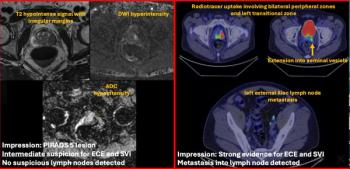
MRI to Determine BPE Levels May Help Predict Breast Cancer
MRI may determine which women at risk for breast cancer most need supplemental screening, based on their BPE levels.
Women who are high risk for breast cancer and who have greater background parenchymal enhancement (BPE) detected by MRI, have a higher probability of developing breast cancer, according to a study published in
Researchers from the University of Washington School of Medicine, Seattle Cancer Care Alliance investigated if qualitative MRI imaging assessments of BPE, the amount of fibroglandular tissue (FGT), and mammographic density affected the risk of developing breast cancer in women who were at high risk.
“To date, it’s been difficult to assess the future risk of breast cancer for women, so there is a strong desire in the oncology community to identify ways to better determine this risk,” study co-author Habib Rahbar, MD, a breast imaging expert at Seattle Cancer Care Alliance and assistant professor at the University of Washington, said in a release. “While breast density is loosely associated with the risk of developing breast cancer, it is unclear whether it or other imaging features can improve upon current risk assessment methods.”
In this retrospective study, the researchers reviewed screening breast MR images from high-risk women, 18 years or older with no history of breast cancer, who were screened at their institution from January 2006 to December 2011. Women who were diagnosed after index MRI imaging (cancer cohort) were matched one-to-one (age and BRCA status) with a control, women who did not develop breast cancer following index MRI.[[{"type":"media","view_mode":"media_crop","fid":"37748","attributes":{"alt":"","class":"media-image media-image-right","id":"media_crop_4995815489072","media_crop_h":"0","media_crop_image_style":"-1","media_crop_instance":"3737","media_crop_rotate":"0","media_crop_scale_h":"0","media_crop_scale_w":"0","media_crop_w":"0","media_crop_x":"0","media_crop_y":"0","style":"float: right; border-width: 0px; border-style: solid; margin: 1px;","title":"Habib Rahbar, MD","typeof":"foaf:Image"}}]]
The amount of BPE, BPE pattern (peripheral versus central), amount of FGT at MR imaging, and mammographic density was assessed on index images and compared between cancer and control cohorts by using conditional logistic regression.
A total of 23 women at high risk for breast cancer, six of whom had BRCA mutations (mean age of 47) but with no history of breast cancer underwent screening breast MR imaging. Twelve were diagnosed with invasive breast cancer during the follow-up interval, and 11 with in situ breast cancer. “Women with mild, moderate, or marked BPE were nine times more likely to receive a diagnosis of breast cancer during the follow-up interval than were those with minimal BPE,” the researchers wrote. “BPE pattern, MR imaging amount of FGT, and mammographic density were not significantly different between the cohorts.”
“MRI could be used in a broader group of women to determine who most needs supplemental screening based on their BPE levels,” Rahbar said. “This is important as we move into an era of more personalized medicine.”
Newsletter
Stay at the forefront of radiology with the Diagnostic Imaging newsletter, delivering the latest news, clinical insights, and imaging advancements for today’s radiologists.




























